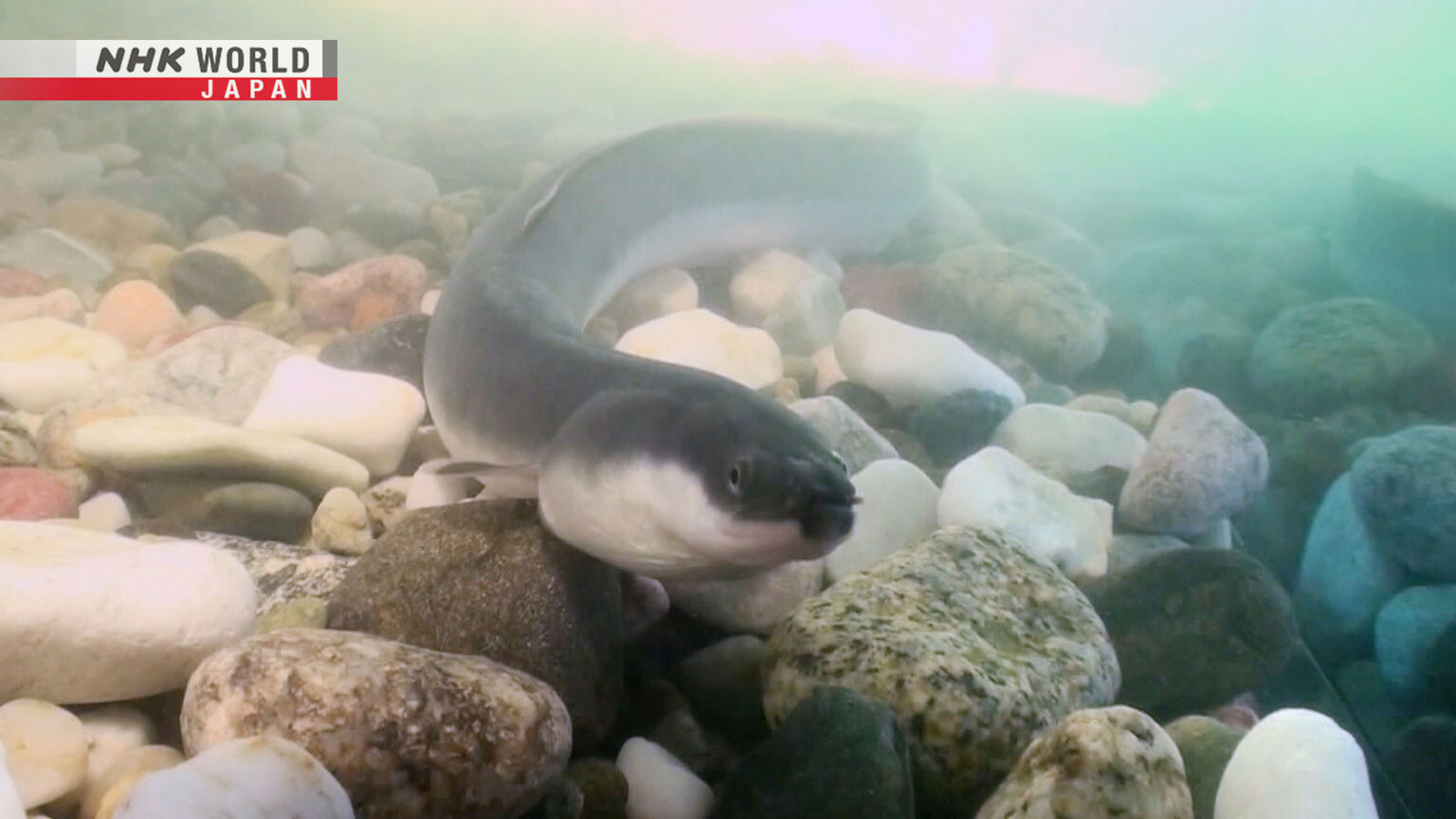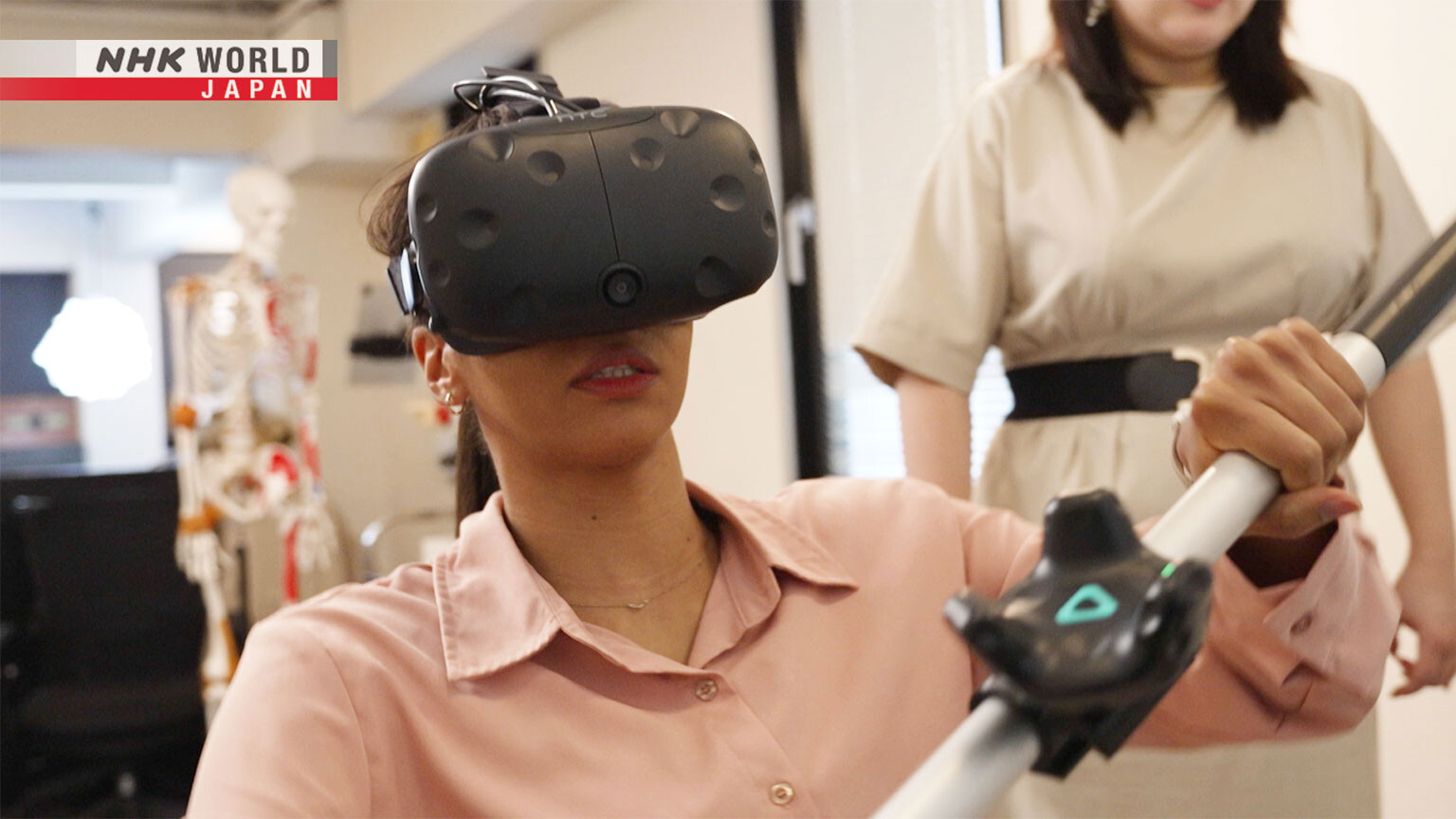Tour of the Mysterious Eel Migration
Discover how eels navigate 3,000km in the vast ocean without getting lost. Also find out about a new technology that can share physical sensations.




Transcript
I've got a question for you.
What would you consider to be quintessential Japanese cuisine?
Sushi? Sukiyaki? Or even Kobe beef?
They're all really good.
But today, we're going to be looking at eel, or unagi, in Japanese.
What we can see here is grilled unagi that is eaten with a soy sauce marinade.
It's not the way Europeans generally eat eel, but I can tell you, it's really excellent.
In Japan, there is a tradition that eating unagi helps keep their stamina up,
particularly during the hot summer months.
Whatever the season, those of us in Japan just can't get enough of unagi.
And in this program today, we're going to be looking at the eel.
Eel has been a delicacy in Japan for centuries.
Although it looks like a snake, it's actually a fish.
Japanese eels are born in the Mariana Ridge, far away from Japan.
After traveling roughly 3,000 kilometers, they reach the rivers in Japan,
where they spend several years feeding on crabs and small fish
before returning to the Mariana Ridge for spawning.
Yet, it had remained unclear as to how they navigate
this long journey across the vast ocean without any sort of landmarks.
It's a bit beyond human imagination.
Taking on the challenge to solve this mystery is Nobuto FUKUDA,
a researcher with 20 years of experience with eels, specializing in the analysis of eel behavior.
Using a certain method, Fukuda had discovered why eels could swim without getting lost.
We didn't know how eels make it to their spawning grounds.
So we simply released them into the waters and chased them with our ship.
You actually chased them?
Yes, we did.
Chasing the eels?
How exactly does that work?
Take a look.
What Fukuda showed us was...
a small device that looked like a AAA battery.
This is an ultrasonic transmitter.
It's inserted into an eel, and we track it
by catching the signals from our ship.
However, the ultrasonic waves emitted by the eels only reach a radius of 1 km.
To catch these signals, they needed to keep chasing the eels with a ship.
It's a challenge because we have to
keep going around the clock.
Large ships cannot change directions quickly
so there's a risk of losing track of them.
In this experiment, eels were released from different points in the ocean.
Not just near Japan, but also further south of their spawning grounds, covering 11 locations.
Amazingly, eels from 10 locations successfully made their way back
to the spawning grounds without getting lost.
How did they do it?
This is the data tracking the eels.
Fukuda's attention was drawn to this:
For some reason, they swim in a circle of about 3 km in diameter once a day.
This circular movement had never been reported
so it was an interesting discovery.
Further investigation revealed that both events took place around noon between 11am and 1pm.
Eels prefer dark environments.
They're reacting to intense sunlight during its peak around noon.
We hypothesized that sunlight is causing them to swim away from it.
Fukuda had focused his attention to the sun.
The sun moves from east to west.
Fukuda speculated that if the eels swam with their back toward the sun,
they would naturally rotate counterclockwise.
Actual data showed that the eels were consistently swimming toward the same direction both before and after noon.
At the time, the they were swimming in the deep sea at a depth of 400 meters.
Even in complete darkness, they were able to detect faint light.
In other words, it may be possible that when eels head toward their spawning grounds at the Mariana Ridge,
they are using the sun and its bearing as a guidepost.
Looking at the sun's path from Japan, it's leaning southward.
However, near the Mariana Ridge, the path is almost directly overhead.
Fukuda believes that the eels leaving from Japan were able to find their spawning grounds
without getting lost, using the difference in the sun's bearing as a clue.
The deep sea and celestial bodies are unknown territories.
Eels travel through uncharted territory when heading to their spawning grounds.
That's why I find this research fascinating.
We're going to hear from someone who works on the team,
whose research has revealed something about the great odyssey that these enigmatic creatures undergo.
FUKUDA Nobuto works in the Japan Fisheries Research and Education Agency.
Hello and welcome.
Thank you for having me.
The survey was quite extensive. Why was it necessary to go to such lengths?
The eel has been a beloved delicacy in Japan,
but their population has drastically decreased in recent years.
To address this, we launched this large-scale research to better understand their ecology.
It means that we don't really understand the ecology of eels.
That's right. We don't know much about the eels in the rivers,
let alone those that head out to the sea for spawning.
There's still much to learn.
You discovered that Japanese eels migrate southward relying on the sun. Were you surprised by that?
Yes. The eel is known to swim in the deep waters,
so it's unclear how much they can see the sun in the darkness.
When the sun is in the south, they move in that direction.
And when it's in the north, they head north.
So they probably use the sun to determine which way to go.
Sunlight is scattered by the particles in the water,
but they can still sense it, showing just how sensitive they are.
Typical marine creatures have not been reported to rely on solar compass for navigation.
It's not my area of expertise, but from papers I've read on light analysis,
the clearer the ocean when sunlight enters the water, the more likely
it is to retain that angle.
If the eels are sensitive to this, the sun could act as a beacon for them.
Right. So with less mud particles and scattering it's easier for them to navigate.
Have you discovered anything else from the ultrasonic tracking?
With the system, we can track the depth of the eel.
During the day, it's around 700~800m deep.
At night, it comes up to about 200m deep.
We found that they repeat this up-down pattern daily.
They migrate southward while changing depths. Why is that?
They probably swim in the deep dark waters during the day
to avoid being detected by predators such as sharks.
It gets dark at night, so they swim in the shallow areas.
The alternating swimming depth exhibited by the eel has shown to play an even more important role.
We visited the Shizuoka Prefectural Research Institute of Fishery and Ocean, an area famous for eels.
Here, Yu KURAISHI investigates the ecology of eels.
What exactly is his research about?
My experiment replicates the migratory behavior of eels during their spawning migration.
How does he replicate the movement of swimming up and then down hundreds of meters?
This is what he showed us.
We conducted the experiment in this tank.
This tank? I imagined it would be larger.
Yes, we replicated the eel's change in swimming depth in this tank.
The secret is behind the seawater being poured into the tank.
This system uses a timer to switch the seawater when it's time.
This alternates the water temperature between warm and cold.
Kuraishi focused on the temperature variance in seawater caused by the difference in water depth.
In the experiment, the eels were kept in cold 12-degree seawater during the daytime,
and switched to warm water of 25 degrees at night.
This enabled the replication of the temperature changes experienced by the eels.
What happened to them after continuing this experiment for 1 year?
This is an eel used in the experiment.
At first glance, we can't see any noticeable changes.
However, there were surprising changes found inside its body.
We found that
the levels of reproductive hormones were twice as high.
Here is a graph showing the concentration of sex hormones in their blood.
Compared to eels raised in only warm water, eels raised in alternating water temperature had
an average 2.2-fold increase in the essential reproductive hormone 11-KT.
There might be a switch triggered by the drop in water temperature.
They feel a certain type of stress, and as this cycle is repeated, it may be
gradually pushing them towards maturity.
Kuraishi believes that the stress caused by the change in water temperature
stimulated their survival instincts and facilitated their physical maturity.
The mysterious swimming pattern had been an essential element in becoming a parent eel.
Alternating the swimming depth helped the eel grow to maturity.
Yes. There's something I want to share with you.
This is a valuable photo of a male eel upon reaching the spawning ground
after swimming 3,000 km.
All of this is the sperm, making up 40% of its body weight.
Their bellies are bulging.
Eels use up all of their energy for reproduction until the end of their life.
That makes them more fish-like than a snake.
So they fill up their bellies and leave everything for their offspring.
And then they die?
Yes. They embark on a long journey, once in their lifetime never to return.
Do male and female eels head south together or do they meet at the destination?
It's still unclear.
Whether they meet shortly after leaving Japan and swim together to the breeding grounds,
or if they meet each other there. The details are still unknown.
But we do know that eels spawn in summer
during the new moon on dark summer nights.
They decide when and where to meet for spawning.
Then they lay eggs and babies are born. What is that like?
The offspring of an eel is called a leptocephalus and it's flat and transparent.
Looks like a see-through leaf.
To make their way to Japan from their birthplace, they travel the 2,000 to 3,000 km journey
by riding ocean currents.
To avoid being detected by predators, they are transparent
and said to have a leaf-like form to help them drift with the currents.
During that time, they must eat. Do you know anything about that?
Marine snow,
the remnants of organic material broken down by bacteria, falls to the seafloor.
Eels are known to feed on this.
However, we still don't know what organisms make up this marine snow.
It's said that eels probably consume whatever
makes up the marine snow in that vicinity.
They basically gulp down everything that's there.
Professor FUKUDA, what are your plans for your future research?
We know that eels reproduce in areas like the West Mariana Ridge.
However, we still have little understanding
of their actual reproductive behaviors.
So I'm interested in studying more about their reproductive ecology.
I see. That could also lead to the business of eel farming.
Yes. I also have that in mind.
Currently, we are developing a technology to artificially produce glass eels from eggs.
Understanding the natural ecology can provide significant insights to their behavior.
Yes. That would make eel dishes more affordable.
As a fan of eel myself, I wish you success in farming
and of course in the field of science.
Yes, thank you.
Now, let's move to our Vanguard Researchers,
whose research has the potential to change the way that we live.
We'll see how you can be confined to a bed or a chair
and still experience things like playing sport or a musical instrument.
It's a system which digitizes movement and the sense of touch
and allows this information to be shared with others.
Who knows in the near future, maybe we can really feel
what it's like when a baseball player goes out to bat in the major leagues.
How many times have you traveled to a different country?
According to a survey, people average about 2-3 cross border trips per year.
Now, imagine if you could experience a trip to another country from the comfort of your own home.
Your experiences could greatly enrich your life.
Meet today's Vanguard Researcher who is taking on the challenge
to realize such a future with groundbreaking inventions.
Emi TAMAKI utilizes cutting-edge technology to study human sensations.
This system shares sensory experiences globally.
It involves input and output of proprioceptive sensations
like weight, force, and body position into a computer.
Proprioception refers to the awareness of movement, weight, and position that are felt deep within the body.
By adding extra information,
you experience activities like sports or moving with a robot
as if you're doing it firsthand.
In Tamaki's research, she starts by measuring and digitizing muscle movements when the body is in motion.
Using the data, she then shares the experience with others through different devices,
allowing both parties to feel the sensation of moving in the same way.
I had the chance to give it a try.
Please wear this "muscle deformation sensor" belt on your right hand.
Looks like a watch.
First, the belt is strapped onto my wrist to convert my senses into data.
There are 14 muscle deformation sensors on the device
to precisely examine the degree of muscle contraction from even the slightest bulge.
Now, let me analyze your baseball swing.
I'm not that good at baseball.
I stood in front of the monitor and recorded 2 patterns:
a light swing and a more aggressive swing.
We also decided to try a golf swing.
Can you see the AR balls on the screen?
The yellow ball shows the strength of your pinky and ring finger.
The red ball shows the strength of your middle finger, index finger and thumb.
The yellow is bigger.
Yes. For bat swings, having red is better, with strong index and middle fingers.
I guess I'm not cutout for baseball.
You'll improve with a little practice,
but in some sports, it's better to have more pressure in your little and ring fingers.
- What sport is that?
- Golf.
Having more strength in yellow, you might improve faster in golf.
I see.
Using this muscle deformation sensor,
we see that professionals, amateurs and beginners have different experiences.
This technology can precisely capture the amount of force applied,
something that only the individual themselves can truly feel.
Now, let's move on to the next step: sharing the digitized proprioceptive experience.
This next device uses electrical stimulation to convey proprioception.
Earlier, we used sensors to input muscle force and position into the computer.
This time, the proprioception in the computer will be output through this device.
Here is the device.
Electrical stimulation transmitted to the metal plates is supposed to let me feel weight and impact.
Now, you're going to experience holding a falcon. You'll feel the pain and impact.
Sounds painful!
I will experience traditional falconry, a practice that dates back centuries in Japan.
After catching its prey, the falcon will return to my arm.
The proprioceptive sensation of having a falcon on the arm has been pre-recorded.
What is it going to feel like?
It responds when you apply pressure.
It's approaching slowly, so it's kind of scary.
Hurry up!
Ahh!
The moment the falcon landed, I could clearly feel the pain and weight.
It incorporates not just visual and auditory cues but also proprioception.
The added sensation like impact or pain makes the experience immersive and real.
Being able to see with the red and the yellow circles,
how much power I was using, was really interesting.
Also, being able to feel something that wasn't actually there,
but to be able to have that sensation in my body was really interesting.
I've never felt that before.
I'm excited to see where this technology goes in the future.
Now, Tamaki is developing a technology to experience kayaking indoors.
In addition to sound and scenery, you can also feel the weight of the water,
offering an interactive and immersive shared experience.
Tamaki continues her efforts to enrich lives through the technology of sharing experiences.
Sharing experiences with others
enriches our lives whether they're long or short.
I want to feel various emotions through different experiences.
That's the motive that drives me.
I hope to pack 3 lifetimes' worth of experiences into one, and live life to the fullest.
I can imagine a time in the near future when people with mobility issues will be able to
experience the outside world in ways that hasn't been possible up till now.
I hope you enjoyed hearing about those highlights of research in Japan and I look forward to
the next time we can take a journey into the wonderful world of science and technology.